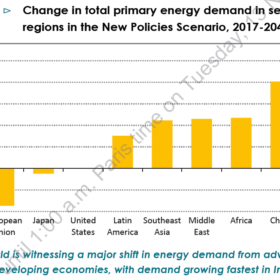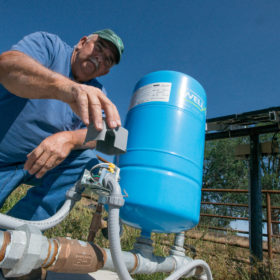German researchers achieve 25.5% efficiency for perovskite tandem solar cells
The research team was able to improve the cell efficiency by 2.1%. The cell silicon layer was etched on the back-side, while a a polymer light management (LM) foil was applied to the front-side of the device.
The long read: Cutting down on copper
Controllable, distributed battery storage systems can help avoid bottlenecks in power distribution networks. That reduces the cost of grid expansion, but to turn this use of storage systems into a business model, a number of conditions still have to be met.
India’s energy demand will more than double by 2040 – IEA
The world is witnessing a major shift in energy demand from advanced to developing economies, with demand growing fastest in India – according to the International Energy Agency’s (IEA’s) latest World Energy Overview.
The weekend read: Getting rolling
The first companies are demonstrating that today it can be worthwhile commercially to back electric vehicles in combination with solar generation and storage. Particularly in the case of public charging stations, solar power used for electric vehicle charging could become the basis for a profitable operator model in the future.
Hits and misses among latest 10 GW solar tender amendments
While the timelines for PV power plant execution and completion of manufacturing facilities are now more realistic, production obligations – especially for capacity utilization – need to be revisited.
Video: Future PV Roundtable REI 2018
Innovation continues to be a driver of the global PV industry. India is no exception as the sector continues to pursue the ambitious goal of 100 GW by 2022. But what is the latest status of innovative PV power plant componentry, design and execution in India in 2018? And what are key drivers and constraints […]
The long read: Let’s get digital
As price pressure continues to exert its strong grip on the inverter market, digital services make their way into the offerings of manufacturers. The new technologies create the possibility to steadily generate profits, and thus create resilience to market fluctuations. But they also allow the installation of more solar assets, as they cater to the need to improve grid resilience to compensate for intermittent renewable energy.
‘SECI’s 10 GW solar tender will not attract big developers’
Big players such as Acme, ReNew, Adani, Azure, Hero Future and Aditya Birla Solar are likely to stay away from procurement which requires 3 GW annual manufacturing commitment, says industry insider Gopal Lal Somani.
The long read: “The potential gain from bifacial easily outweighs the risks”
An unexpectedly large gathering of international bifacial PV experts convened in Denver, USA in early September, at the 2018 bifiPV Workshop to trade notes on the performance of bifacial PV modules, lauded by some as the most promising advance in solar for a decade. pv magazine was in attendance.
Rural India a $50 billion market for clean energy innovations
The farming sector offers the largest green energy innovation opportunity, with rice transplanting, pesticide spraying and grain harvesting together having a market potential worth $40 billion – says the Council on Energy, Environment and Water.















